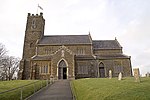Church of St Mary, Almer, Dorset

Church of Mary is a Grade I listed church in Almer, Dorset, England. It became a listed building on 18 March 1955. According to Arthur Mee's The King's England: Dorset (ISBN 0-340-00079-1), "the embattled tower is 15th Century, and has a fine arch. In a chancel window is much old glass with fragments of drapery, architecture, and fleur-de-lys; the centre panel has bright-hued glass pictures by Continental artists of the days when men and woman wore stiff ruffs about their necks. One window has what appears to be a group of saints, the other has the Last Judgment, with Our Lord enthroned among angels blowing trumpets. A good soul is being rescued by an angel with lilac wings and a blue dress, while a crimson demon with golden horns is seizing a wicked one."
Excerpt from the Wikipedia article Church of St Mary, Almer, Dorset (License: CC BY-SA 3.0, Authors, Images).Church of St Mary, Almer, Dorset
Geographical coordinates (GPS) Address External links Nearby Places Show on map
Geographical coordinates (GPS)
| Latitude | Longitude |
|---|---|
| N 50.7899 ° | E -2.1246 ° |
Address
St Mary
DT11 9EP , Sturminster Marshall
England, United Kingdom
Open on Google Maps








